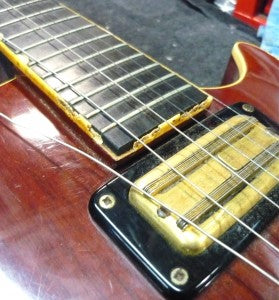Gretsch refret and binding
Share
This was an early seventies Gretsch that was in desperate need of some lovin'. It has serious "binding rot" and needs a refret badly.
Binding rot can be caused by several things but old Gretsches are notorious for it. It mainly happens when the gasses released from the binding material and/or glue react with binding and eat it away. It's now getting harder to find an old Gretsch that hasn't had binding work. This is a pretty usual example.
This guitar hadn't been played in years according to the customer. Every time he picked it up more binding fell off. It was uncomfortable and hard to play. As I've said I don't like to mess too much with vintage instruments and I don't do refrets and this kind of work at the drop of a hat like other repairers but this one NEEDED doing so he could actually use it.
The binding just fell off like brittle toffee for the most part. It chipped and fell off in small parts but was fairly easy to clean off and get ready for the refret, which I'll do before the binding as I want to finish with "nub end"binding like this had originally. With the binding channels all clean it was time to pull the frets.
Old ebony can actually be very brittle and chips quite easily so fretboards like this and old Les Paul Customs can be difficult.
The frets came out pretty well and it was time to clean the whole lot up and flatten the fretboard ready for the new frets. Checking slot depth and width is important here as some of these old guitars had very strange sized frets in them and trying to push an over sized fret into a small slot can break and/or chip the ebony badly.
The new frets went in well and the edges were trimmed at a right angle to the edge of the fretboard binding slot. Remember, I don't want these on an angle like "normal" refrets as I'm going to run binding right up to the edge of the fret.
This method of nub end binding is more work but most of the more expensive US made guitars from the 50's had this type of binding.
I make my own binding glue and I get my binding from the lovely people at Maton. They only do three colours but it's the most common types and their binding is GREAT quality.
The binding is glued and taped like this for the glue to dry. The more tape, the better as you really want great contact between the timber and the binding. I leave it for a few days to dry fully before I start working it.
With the glue dry and the binding set nicely it's time to start working on the nub ends. This is a process where the binding at the end of each fret is shaped into the end of the fret. So the fret has a small plastic "nub" at each end.
Like I say, it's more work but does look great when it's done.
The process means carving out the excess binding between each fret and then shaping the ends to be a little nub. It is very time consuming and if you slip or break a nub off, it's A LOT of work to fix so you've got to be extra careful.
Once all your ends are shaped it's time to do a bit of "blending" and then it's pretty much a fret dress and set up. The final shaping and "feel"makes a lot of difference so alittle more time here makes the neck feel used or new. On a guitar like this you really want a "used" feel.
With the fretboard and binding finished it was a quick check over and then back together for the first time in years. It's nice to see an old beauty like this get back into action and being played. These semi hollow Gretsches are something else. They sound amazing and have great necks, when they're not falling apart.


























